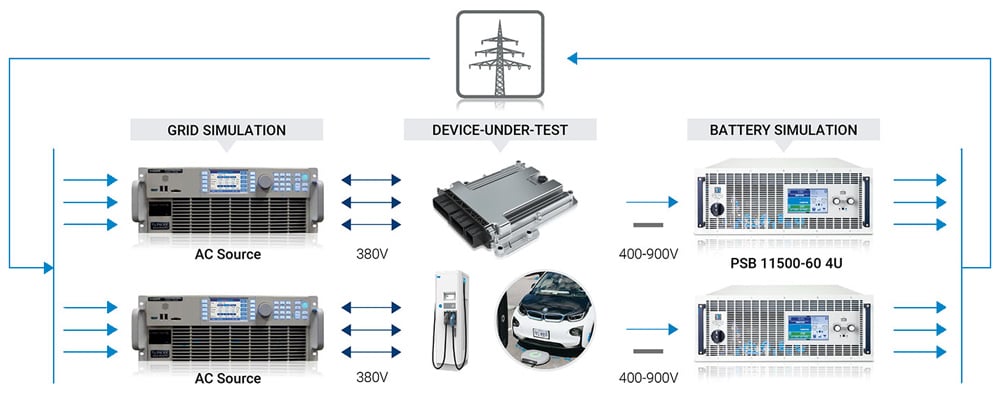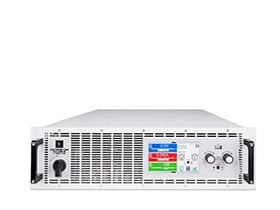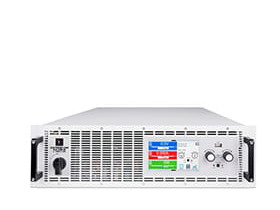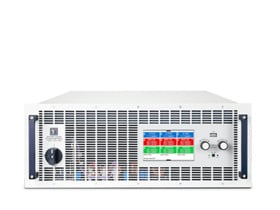與我們聯絡
與 Tek 業務代表即時對談。 上班時間:上午 6:00 - 下午 4:30 (太平洋時間)
請致電
與 Tek 業務代表即時對談。 上班時間:上午 8:30 - 下午 5:30 (太平洋時間)
下載
下載手冊、產品規格表、軟體等等:
意見回饋
應用方案
電池測試
使用 EA PSB 雙向電源供應器進行高效電池測試
因此,電池變得更小,效率也越來越高。為了跟上科技進步的速度,用來測試先進科技的設備也必須先進、靈活且反應迅速。基於這些原因,EA Elektro-Automatik 的 PSB 雙向可程式直流電源供應器系列是進階電池測試的最佳選擇。
PSB 雙向電源可以在提供電源為電池充電和控制電池放電之間無縫切換。PSB、PSI、EL 及 ELR 產品系列內建電池充電、靜電放電及動態測試功能。EA 可協助指定正確的設備,並就如何建立強大的電池測試系統提供一些基本指導和注意事項,以確保所有測試設備和被測電池的安全和正常運作。
優點:
- 內建靜電充電、靜電放電和動態測試功能,自動量程
- 功率密度
- 雙向和再生
- 任意波形和函數訊號產生器
- 低 EMC
- 輸出電壓高達 2,000V
- 隨插即用並列操作
電池充電
使用可編程直流電源供應器為電池充電,例如鋰離子電池。
客戶經常要求提供中功率或高功率電池充電器,以滿足與汽車電氣化(EV)相關的各種專案,例如電動自行車、混合動力或全電動汽車或卡車。這些電池充電器經常被用作電動車環境中電池測試平台的一部分,以進行循環、性能和年限測試。此外,測試機台通常會配備與所要測試電池類型相符的控制、監控和安全機制。
此類以電池測試為目標的測試平台需要一個具備適當介面(類比或數位,例如)的可程式化直流電源供應器。CAN)具有高精度、高解析度和低漣波。它可作為可調整且高度靈活的直流電源主幹,使測試台可連接許多不同類型的電池單元或電池組,並具有不同的額定電壓和容量。EAs 電源供應器具有內建的電池充電功能,當充電電壓達到或電池容量達到時會自動停止。
優點:
- 內建靜態充電、靜態放電和動態測試功能,自動量程
- 功率密度
- 雙向再生
- 任意波形與函數產生器
- 低 EMC
- 輸出電壓高達 2000V
- 隨插即用並列操作
電池模擬
使用可程式化雙向直流電源供應器模擬鉛酸及鋰離子電池。
雙向直流電源供應器天生適合模擬電池,因為它們能夠同時供電和耗電。透過實施模仿特定電池類型的操作曲線,測試工程師可以準確地重現電池電力,以測試那些向電池充電或從電池接收能量的裝置。Elektro-Automatik 的電池模擬器軟體使得模擬鉛酸和鋰離子電池成為可能,包括在充電或放電期間的電氣和化學特性。
EA 與德國著名的 Fraunhofer 研究所合作,以多年的研究成果為基礎,開發出模擬電池的演算法。現在可以在幾分鐘內模擬一組電池在非常特定的充電 (SOC) 狀態,而不必等待電池充電或放電到相同的 SOC。此軟體也會考慮電池容量、內阻、環境溫度,甚至是健康狀態 (SOH)。
優點:
- 與 Fraunhofer 研究所合作開發的演算法
- 自動調整
- 功率密度
- 電池模擬
- 雙向和再生
- 任意波形和函數產生器
- 低電磁相容性
- 輸出電壓高達 2000V
- 隨插即用並聯






